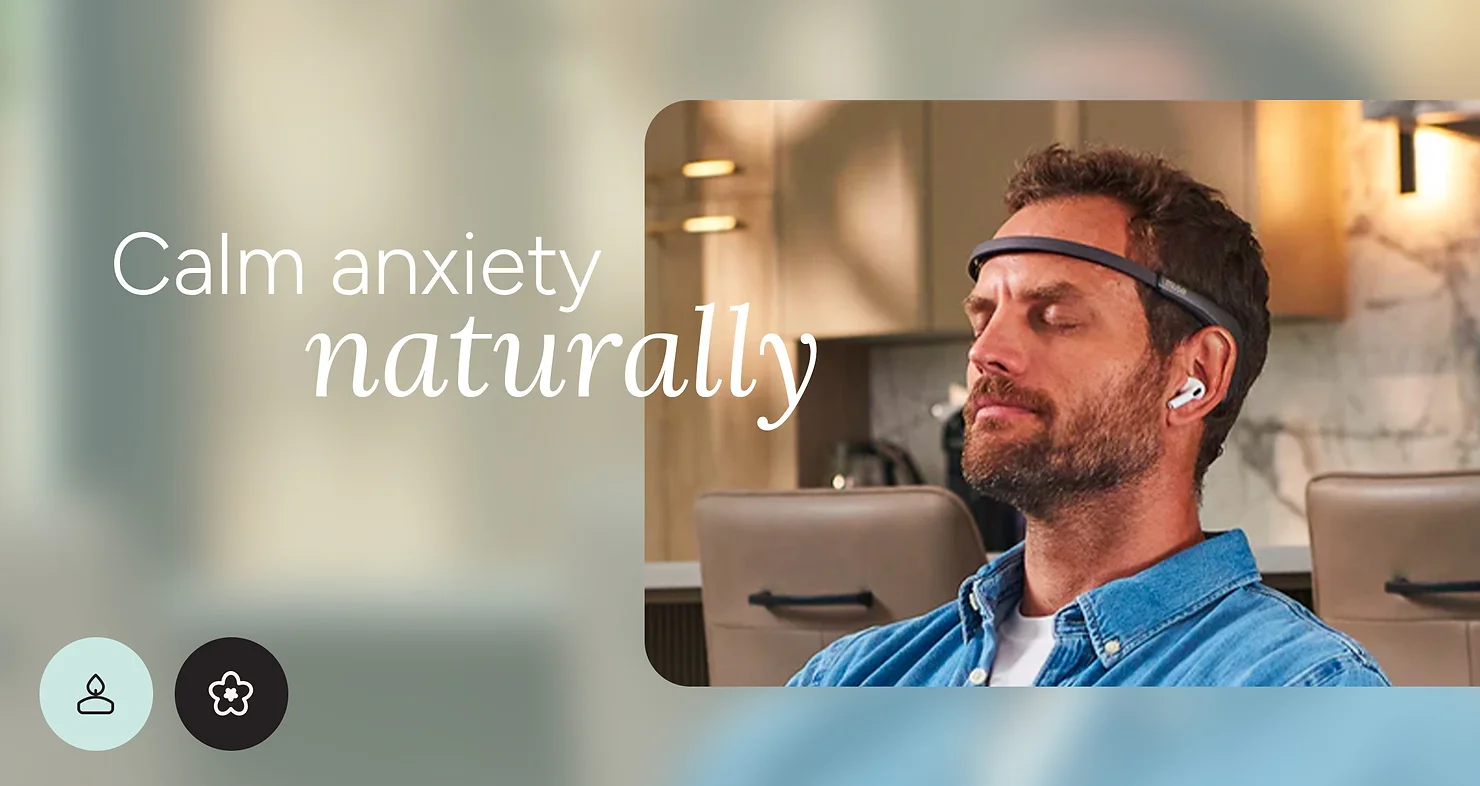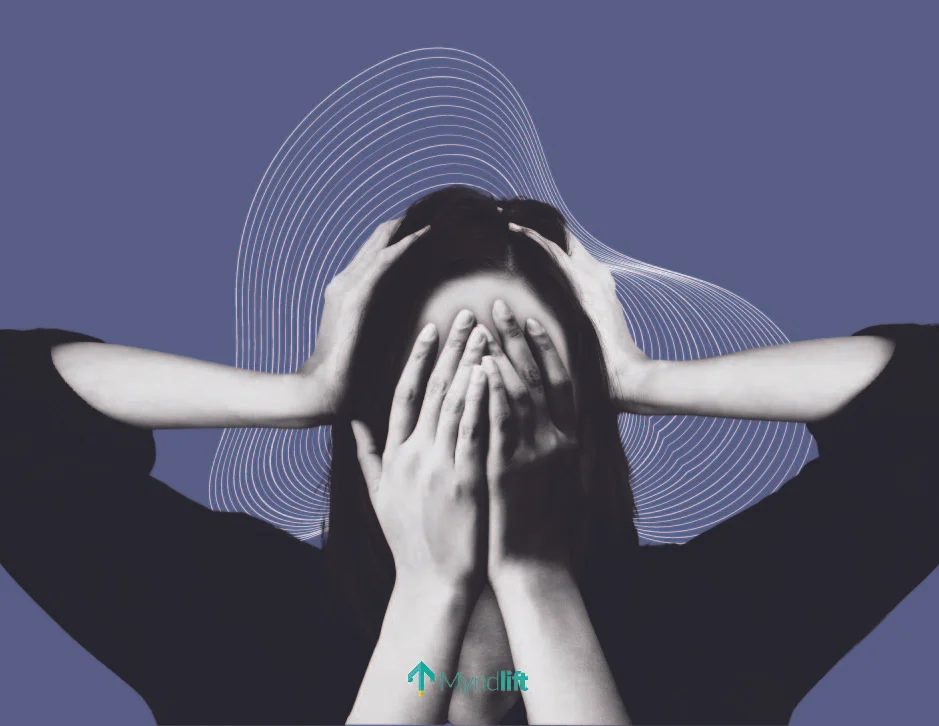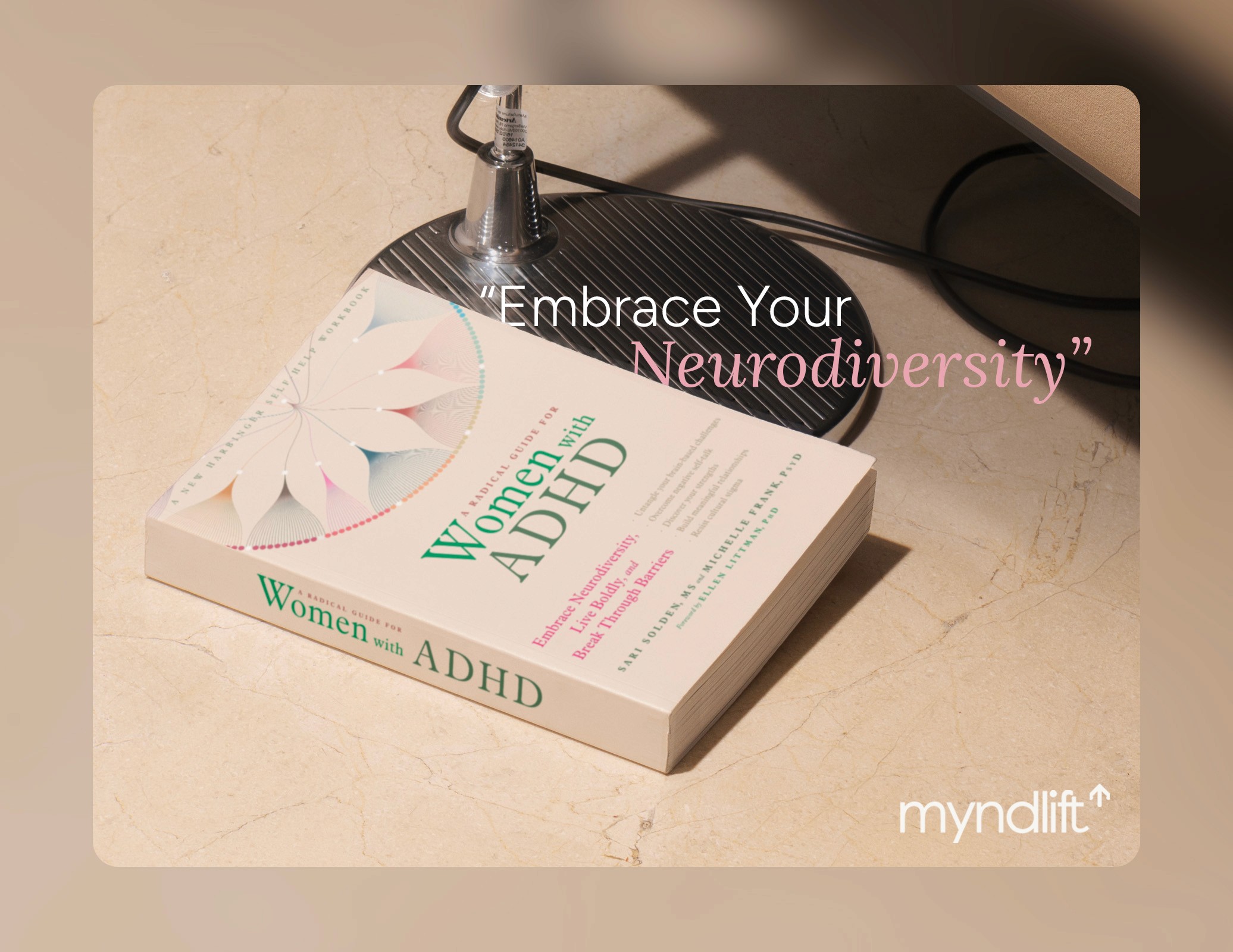In a world where it often feels like the pace is faster than ever before, finding moments of calm can seem out of reach.
In fact, with 19.1% of U.S. adults experiencing an anxiety disorder in the past year, indicating a record high, many individuals are struggling to access professional help.
It's evident that there's a pressing need for practical remedies to alleviate anxiety while people navigate the challenges of getting professional support. And even though there are many ways to calm anxiety, it’s not always easy knowing which approach is right for you.
Here are five science-backed remedies to quiet your mind:
Practicing random acts of kindness
Focusing on hugs to reduce your anxiety
Immersing yourself in nature
Training your brain with neurofeedback
Practicing Aromatherapy
Before we dive in, it’s important to note that, while these techniques can be helpful remedies for anxiety and stress, they’re not a substitute for professional therapy. Instead, try to think of them as companions alongside your healing journey.
1. Practice Random Acts of Kindness
Social connection is vital in making us feel good and improving our overall well-being.
One of the ways to foster such connections is by engaging in acts of kindness. In fact, a study published in 2022 found that performing acts of kindness can make us feel more socially connected, improve our life satisfaction, and reduce symptoms of anxiety and depression.
What’s more, research consistently shows that acting in prosocial and altruistic ways—such as acting kindly, cooperatively, and with compassion—positively influences our mood and overall mental health.
Psychology experts have come up with different explanations for why being kind might be good for our wellbeing, including:
We feel better and more competent when we act prosocially
We distract ourselves from our own stresses and problems
It helps us find meaning and value in life
It provides opportunities for social integration
It boosts our mood
Similarly, a concept called the response shift theory suggests that being kind can change how we see ourselves and what we value, making us more psychologically resilient and less focused on our own worries.
Other theories, like the negative-state relief model and warm-glow giving theory, suggest that being kind can directly improve our mood and give us a sense of satisfaction.
So, being kind isn’t just good for others—it’s good for us too. It can make us feel happier, more connected, and less stressed.
2. Focus on Hugs
Hugs are a natural part of many of our lives, yet we often overlook the many mental and physical health benefits they can have.
Research shows that frequent warm contact (such as hugs) with a loved one can lower your blood pressure and heart rate and increase the activity of the “happy” hormone oxytocin in your body.
In addition to these mental health benefits, evidence suggests that small acts of support through physical touch, such as holding a partner’s arm, can lessen our experience of pain.
In fact, using Functional magnetic resonance imaging (fMRI)—a technique that measures minute changes in the blood flow as a way of detecting brain activity—researchers saw that experiencing pain while being given physical support from a loved one activates the parts of the brain involved in maternal behavior and fear reduction.
They concluded from this that physical support helps us feel socially connected and supported, even during pain.
3. Immerse Yourself in Nature
Immersing yourself in nature is a powerful way to calm anxiety naturally; a practice humans have been using since the beginning of existence. Research demonstrates that being in natural environments, such as going for outdoor walks and gardening, can result in:
Cognitive benefits: Being in nature can improve our attention, put us in a better mood, and reduce the risk of psychiatric disorders.
Emotional benefits: Contact with nature has been associated with increases in happiness, positive affect, positive social interactions, and a sense of purpose in life.
Physical health benefits: Exposure to nature and vegetation can reduce the risk of physical ailments like asthma and reduce high blood pressure, which could prevent related conditions like cardiovascular disease and diabetes.
However, in the modern world of big cities and busy lives, we are spending time in nature far less than ever before. What’s more, mental health difficulties like anxiety and depression may prevent people from leaving their houses, especially on difficult days when symptoms are at their worst.
In these instances, recent research offers an alternative: VR nature environments. VR nature environments may provide anxiety relief, increase positive affect, and reduce negative emotions like anger and fear. It can also eliminate the anxiety felt from being around others.
Why Is Nature a Natural Way to Relieve Anxiety?
Nature is full of shapes, colors, and patterns, one of which is known as a fractal. Fractals are complex, never-ending geometric patterns that look similar under any level of magnification. Pine cones, succulents, and snowflakes are common examples of fractals you often see out in nature.
So, if you were to zoom in on any part of a fractal, you’d see the same pattern no matter how closely you look.
Research using electroencephalogram (EEG) data (recordings of electrical brain activity) found that our frontal lobe produces “feel-good” alpha brainwaves when we view fractal images. These brainwaves are characteristic of a relaxed, awake state.
One study compared the relaxation effect of fractal images when taking a walk in a forest compared to city centers. The researchers tested the participant’s cortisol levels before and after the walks and found that the forest walkers experienced a 15.8% reduction in the stress hormone cortisol. They also noticed a significant 3.9% drop in heart rate and a 1.9% reduction in heart rate.
However, while this research sheds light on one aspect of why nature might relieve anxiety, it’s likely that many factors are at play. For instance, spending time in nature may also offer a break from the fast-paced, technology-driven environments of urban areas, allowing our minds to rest and recharge. Additionally, the presence of natural elements such as fresh air and sunlight has been linked to improved mood and reduced stress levels.
4. Train Your Brain With Neurofeedback
Neurofeedback is a form of personalized brain training that offers promising benefits for alleviating anxiety and reducing depression by targeting electrical activity in the brain.
In this context, neurofeedback operates on the principle that our brainwaves, which reflect our mental states, can be trained to achieve a more balanced, less anxious state.
It involves placing small sensors on the scalp to detect and measure your brain’s electrical activity. Then, through real-time monitoring, experts can begin to understand how your brain functions and identify patterns associated with anxiety or depression.
Once these patterns are identified, you’re given a neurofeedback training plan, which focuses on modulating your brainwaves to a less anxious state. Over time, through repeated neurofeedback sessions, the brain can learn how to self-regulate and adjust its activity patterns, allowing you to feel more emotionally regulated and relaxed.
5. Try Aromatherapy
Aromatherapy is a therapeutic practice that uses essential oils from plants to improve our physical and emotional well-being. Initial studies testing the effectiveness of aromatherapy indicate that smelling essential oils may alleviate anxiety.
For example, a randomized control trial testing the effect of inhaling rose water on anxiety levels in hemodialysis patients found a significant decrease in anxiety symptoms compared to a control group who weren’t given aromatherapy treatment. There have been similar findings when combining rose and lavender essential oils for postpartum anxiety and depression.
However, it’s important to recognize that the results on the effectiveness of aromatherapy are mixed. It’s difficult to rule out biases in studies on aromatherapy, and some studies have been inconclusive.
Based on the research available, aromatherapy may also be effective for sleep problems, insomnia, and headaches.
Final Word on Ways to Calm Anxiety Naturally
In our modern world, it’s easy to feel like time races ahead of us. When we’re rushed off our feet like this, calm can seem difficult to attain.
By focusing on practices rooted in connection and relaxation, we can begin to reclaim a sense of calm in our lives.
But remember, we shouldn’t do this alone. While the methods mentioned in this article have been shown to alleviate anxiety and depression, they aren’t a substitute for professional therapy. However, coupled with professional support, they can help you take significant strides in your healing journey.
Myndlift provides a personalized expert-guided brain training program that can help you elevate your wellbeing by improving your sleep quality, focus, calm, and self-control over mood. Take this 10-second quiz to check if you’re eligible to kick-start your journey for better brain health.
About the author:
Emma Loker
Emma is a practicing trainee Child and Adolescent Psychotherapist studying at the University of Cambridge and a psychology writer with years of experience. She achieved a 1st Class Honors Degree in Psychology from Aston University in Birmingham.
About the checker:
Kaija Sander, Ph.D.
Kaija Sander is a cognitive neuroscientist and scientific consultant for Myndlift. She holds a BSc in Biomedical Science with a specialization in Neuroscience and Mental Health from Imperial College London and a PhD in Neuroscience from McGill University. Her doctoral research focused on brain connectivity relating to second language learning success. She is passionate about the broader applications of science to have a positive impact on people’s lives.
References
Abdullah, S. S. S., Sulaiman, S., Sulaiman, S., Alyan, E., Merienne, F., & Diyana, N. (2021). The Impact of virtual nature therapy on stress Responses: A Systematic Qualitative review. Forest Economics, Policy, and Social Science, 12(12), 1776. https://doi.org/10.3390/f12121776
Ambardekar, N. (2022, January 23). What Is Aromatherapy? WebMD. https://www.webmd.com/balance/stress-management/aromatherapy-overview
Andreoni, J. (1989). Giving with Impure Altruism: Applications to Charity and Ricardian Equivalence. Journal of Political Economy, 97(6), 1447–1458. http://www.jstor.org/stable/1833247
Barati, F., Nasiri, A., Akbari, N., & Sharifzadeh, G. (2016). The effect of aromatherapy on anxiety in patients. Nephro-urology Monthly, 8(5). https://doi.org/10.5812/numonthly.38347
Barton, J., & Rogerson, M. (2017). The importance of greenspace for mental health. BJPsych international, 14(4), 79–81. https://doi.org/10.1192/s2056474000002051
Berman, M. G., Jonides, J., & Kaplan, S. (2008). The cognitive benefits of interacting with nature. Psychological Science, 19(12), 1207–1212. https://doi.org/10.1111/j.1467-9280.2008.02225.x
Bratman, G. N., Anderson, C. B., Berman, M. G., Cochran, B., de Vries, S., Flanders, J., Folke, C., Frumkin, H., Gross, J. J., Hartig, T., Kahn, P. H., Jr, Kuo, M., Lawler, J. J., Levin, P. S., Lindahl, T., Meyer-Lindenberg, A., Mitchell, R., Ouyang, Z., Roe, J., Scarlett, L., … Daily, G. C. (2019). Nature and mental health: An ecosystem service perspective. Science advances, 5(7), eaax0903. https://doi.org/10.1126/sciadv.aax0903
Centers for Disease Control and Prevention. (2023, May 8). How does social connectedness affect health? https://www.cdc.gov/emotional-wellbeing/social-connectedness/affect-health.htm#:~:text=Research%20shows%20that%20social%20connectedness,%2C%20and%20improved%20well%2Dbeing.&text=Social%20connectedness%20is%20the%20degree,for%2C%20valued%2C%20and%20supported.
Cohen, S., Janicki-Deverts, D., Turner, R. B., & Doyle, W. J. (2014). Does hugging provide Stress-Buffering social Support? A study of Susceptibility to Upper respiratory Infection and illness. Psychological Science, 26(2), 135–147. https://doi.org/10.1177/0956797614559284
Conrad, P., & Adams, C. (2012). The effects of clinical aromatherapy for anxiety and depression in the high risk postpartum woman – A pilot study. Complementary Therapies in Clinical Practice, 18(3), 164–168. https://doi.org/10.1016/j.ctcp.2012.05.002
Cooke, B., & Ernst, E. (2000). Aromatherapy: a systematic review. The British journal of general practice: the Journal of the Royal College of General Practitioners, 50(455), 493–496.
Cregg, D. R., & Cheavens, J. S. (2022). Healing through helping: an experimental investigation of kindness, social activities, and reappraisal as well-being interventions. The Journal of Positive Psychology, 18(6), 924–941. https://doi.org/10.1080/17439760.2022.2154695
Donovan, G. H., Gatziolis, D., Longley, I., & Douwes, J. (2018). Vegetation diversity protects against childhood asthma: results from a large New Zealand birth cohort. Nature Plants, 4(6), 358–364. https://doi.org/10.1038/s41477-018-0151-8
Grewen, K. M., Anderson, B. J., Girdler, S. S., & Light, K. C. (2003). Warm partner contact is related to lower cardiovascular reactivity. Behavioral medicine (Washington, D.C.), 29(3), 123–130. https://doi.org/10.1080/08964280309596065
Hagerhall, C. M., Laike, T., Taylor, R. P., Küller, M., Küller, R., & Martin, T. P. (2008). Investigations of human EEG response to viewing fractal patterns. Perception, 37(10), 1488–1494. https://doi.org/10.1068/p5918
Hui, B. P. H., Ng, J. C. K., Berzaghi, E., Cunningham-Amos, L. A., & Kogan, A. (2020). Rewards of kindness? A meta-analysis of the link between prosociality and well-being. Psychological bulletin, 146(12), 1084–1116. https://doi.org/10.1037/bul0000298
Inagaki, T. K., & Eisenberger, N. I. (2012). Neural correlates of giving support to a loved one. Psychosomatic medicine, 74(1), 3–7. https://doi.org/10.1097/PSY.0b013e3182359335
Kumar, K. (2020, December 3). How Do Hugs Make You Feel? Medicine Net. https://www.medicinenet.com/how_do_hugs_make_you_feel/article.htm
Lee, Y. L., Wu, Y., Tsang, H. W., Leung, A. Y., & Cheung, W. M. (2011). A systematic review on the anxiolytic effects of aromatherapy in people with anxiety symptoms. Journal of alternative and complementary medicine (New York, N.Y.), 17(2), 101–108. https://doi.org/10.1089/acm.2009.0277
Light, K. C., Grewen, K. M., & Amico, J. A. (2005). More frequent partner hugs and higher oxytocin levels are linked to lower blood pressure and heart rate in premenopausal women. Biological psychology, 69(1), 5–21. https://doi.org/10.1016/j.biopsycho.2004.11.002
Lillehei, A. S., & Halcon, L. L. (2014). A systematic review of the effect of inhaled essential oils on sleep. Journal of alternative and complementary medicine (New York, N.Y.), 20(6), 441–451. https://doi.org/10.1089/acm.2013.0311
Liszio, S., Graf, L., & Masuch, M. (2018). The relaxing effect of virtual nature: Immersive technology provides relief in acute stress situations. Annual Review of CyberTherapy and Telemedicine, 16, 87–93.
Midlarsky, E. (1991). Helping as coping. In M. S. Clark (Ed.), Prosocial
behavior (pp. 238 –264). Sage.
National Institute of Mental Health (NIMH) (n.d.). Any anxiety disorder. https://www.nimh.nih.gov/health/statistics/any-anxiety-disorder
Park, B. J., Tsunetsugu, Y., Kasetani, T., Kagawa, T., & Miyazaki, Y. (2010). The physiological effects of Shinrin-yoku (taking in the forest atmosphere or forest bathing): evidence from field experiments in 24 forests across Japan. Environmental health and preventive medicine, 15(1), 18–26. https://doi.org/10.1007/s12199-009-0086-9
Pieters, H. C., Ayala, L. M., Schneider, A. B., Wicks, N., Levine-Dickman, A., & Clinton, S. (2019). Gardening on a psychiatric inpatient unit: Cultivating recovery. Archives of Psychiatric Nursing, 33(1), 57–64. https://doi.org/10.1016/j.apnu.2018.10.001
Post S. G. (2005). Altuism, happiness, and health: it's good to be good. International journal of behavioral medicine, 12(2), 66–77. https://doi.org/10.1207/s15327558ijbm1202_4
Sasannejad, P., Saeedi, M., Shoeibi, A., Gorji, A., Abbasi, M., & Foroughipour, M. (2012). Lavender essential oil in the treatment of migraine headache: a placebo-controlled clinical trial. European neurology, 67(5), 288–291. https://doi.org/10.1159/000335249
Schertz, K. E., & Berman, M. G. (2019). Understanding nature and its cognitive benefits. Current Directions in Psychological Science, 28(5), 496–502. https://doi.org/10.1177/0963721419854100
Schwartz, C. E., & Sendor, M. (1999). Helping others helps oneself: response shift effects in peer support. Social science & medicine (1982), 48(11), 1563–1575. https://doi.org/10.1016/s0277-9536(99)00049-0
Shanahan, D. F., Bush, R. a. B., Gaston, K. J., Lin, B. B., Dean, J., Barber, E., & Fuller, R. A. (2016). Health Benefits from Nature Experiences Depend on Dose. Scientific Reports, 6(1). https://doi.org/10.1038/srep28551
Whitehead, J. C., Neeman, R., & Doniger, G. M. (2022). Preliminary Real-World evidence supporting the efficacy of a remote neurofeedback system in improving mental health: Retrospective Single-Group Pretest-Posttest study. JMIR Formative Research, 6(7), e35636. https://doi.org/10.2196/35636






